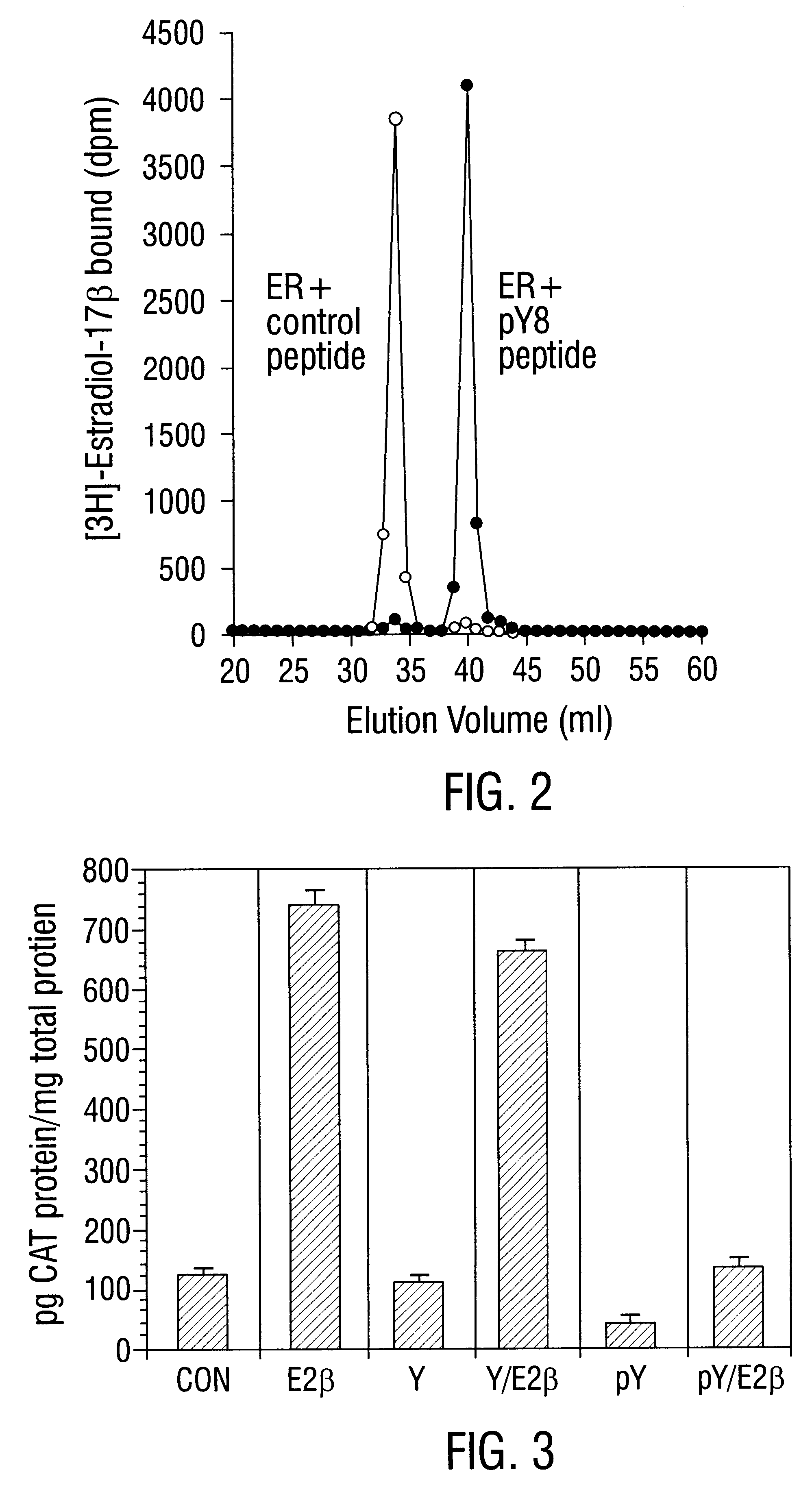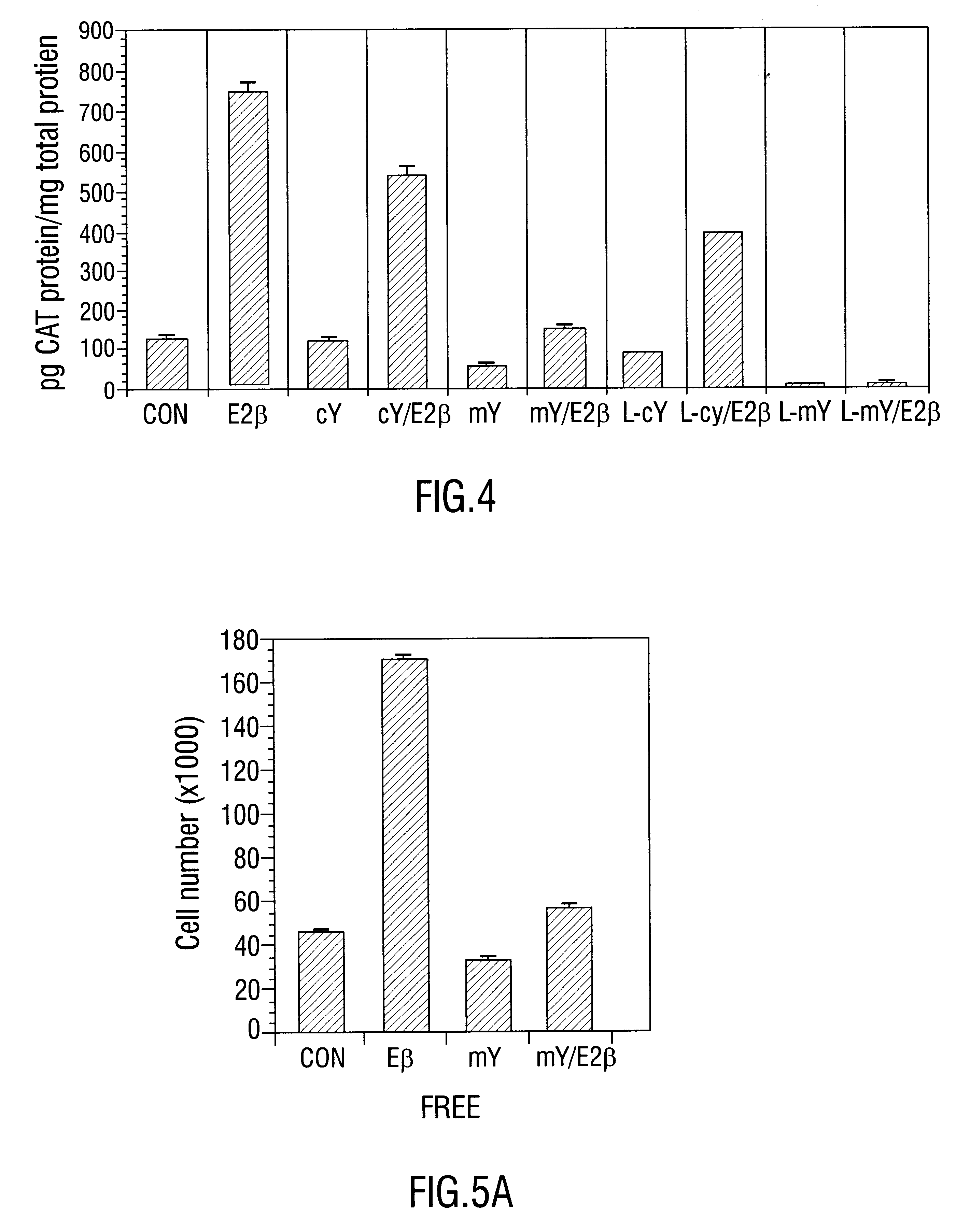Peptide antiestrogen compositions and methods for treating breast cancer
a technology of compositions and peptides, applied in the direction of peptides, drug compositions, nuclear receptors, etc., can solve the problems of reducing the effect of tamoxifen and other anti-estrogen treatment, reducing the background, and reducing the risk of breast and ovarian cancer
- Summary
- Abstract
- Description
- Claims
- Application Information
AI Technical Summary
Benefits of technology
Problems solved by technology
Method used
Image
Examples
example 1
5.1 Example 1
Antitumor Effect of Phosphotyrosyl Peptide Analogs Targeted to ER
It has been shown that purified recombinant human ER from MCF-7 breast cancer cells reacts specifically with synthetic ERE in a gel mobility shift assay, allowing formation of an ER-ERE complex. This interaction is eliminated by competition with 0.01-10 .mu.M phosphotyrosine but not by competition with 0.01-50 .mu.M phosphoserine. Since site directed mutagenesis studies show that Tyr537 is the predominant phosphotyrosyl residue in ER, several peptides were prepared which contain the sequence corresponding to the phosphorylation site at Tyr537 in ER (Arnold et al., 1995a; Arnold and Notides, 1995; Arnold et al., 1995b; Castoria et al, 1993). The phosphorylated octapeptide, pY, contains the sequence PLpYDLLLE (SEQ ID NO:2), and its nonphosphorylated analog, Y, has the sequence PLYDLLLE (SEQ ID NO:1).
By application of molecular sizing chromatography with Sephadex G-200 (Pharmacia), it was found that the phosp...
example 2
5.2 Example 2
Antitumor Effect of Phosphotyrosy Peptide Analogs Targetd to Disrupt DNA Binding of ER in Human Breast Cancer
This example describes the effect of phosphotyrosyl peptides on ER dimerization and DNA binding. Eight- to ten-amino acid phosphotyrosyl- and phosphotyrosyl-mimeticpeptides with sequences surrounding ER Tyr537 were prepared and tested for their efficacy in the blockade of ER dimerization and in the suppression of ER binding to ERE. Phosphatase-resistant malonyltyrosyl-peptides designed for in vivo application are also evaluated for inhibition of ER-regulated transcription and for antitumor activity. These data show that peptides targeted to disrupt dimerization and DNA binding of ER proteins offer a new class of antiestrogens for cancer therapy.
5.2.1 Methods
5.2.1.1 Preparation of Peptide Antiestrogens
Phosphotyrosineand phosphoserine were obtained in pure form (Sigma, St. Louis, Mo.). Octapeptides and decapeptides with or without phosphotyrosine (UCLA Peptide Synt...
example 3
5.3 Example 3
Activity and Selectivity of Peptides in Vitro and in Vivo Assays
To address the issue of selectivity, it is important to review biologic information about the sequence of the estrogen receptor (ER) that is targeted by the small peptide antiestrogens. This region of the estrogen receptor is highly conserved in estrogen receptors found among all species ranging from human to amphibians (Table 6)
In addition, this region, YDLLLEML (SEQ ID NO:32), is also found in the newly discovered estrogen receptor-s which has been reported to form functional dimers with the classical ER (Cowley et al., 1997). In contrast, the tyrosine residue found among estrogen receptor family members in this region is not conserved in other nuclear receptors, such as glucocorticoid receptor, progesterone receptor or androgen receptor. These sequence data suggest a strong likelihood for selectivity within the estrogen receptor family, with the exclusion of other nuclear hormone receptors.
To test the se...
PUM
| Property | Measurement | Unit |
|---|---|---|
| Fraction | aaaaa | aaaaa |
| Fraction | aaaaa | aaaaa |
| Percent by mass | aaaaa | aaaaa |
Abstract
Description
Claims
Application Information
 Login to View More
Login to View More - R&D
- Intellectual Property
- Life Sciences
- Materials
- Tech Scout
- Unparalleled Data Quality
- Higher Quality Content
- 60% Fewer Hallucinations
Browse by: Latest US Patents, China's latest patents, Technical Efficacy Thesaurus, Application Domain, Technology Topic, Popular Technical Reports.
© 2025 PatSnap. All rights reserved.Legal|Privacy policy|Modern Slavery Act Transparency Statement|Sitemap|About US| Contact US: help@patsnap.com



